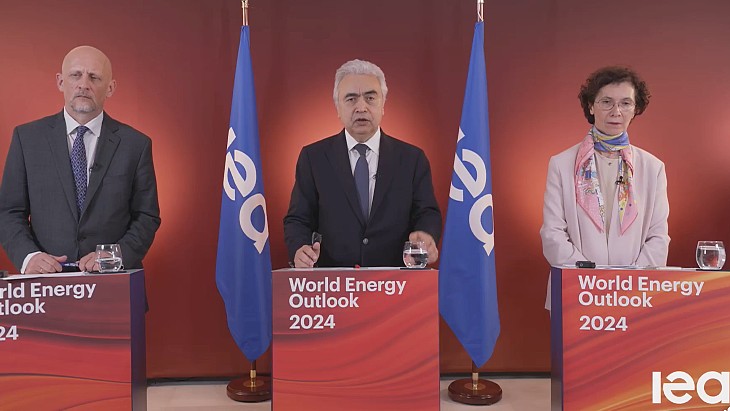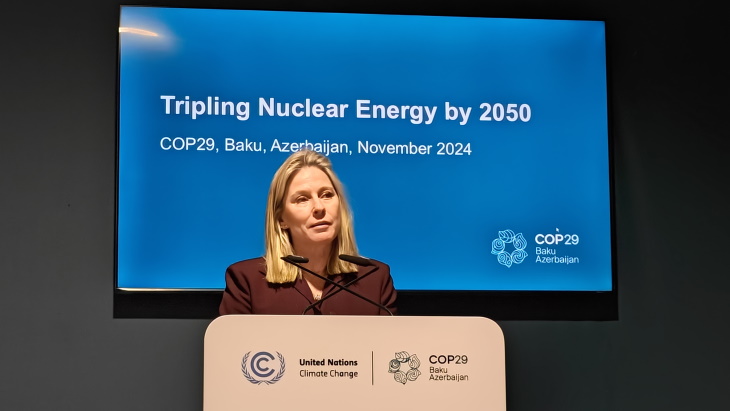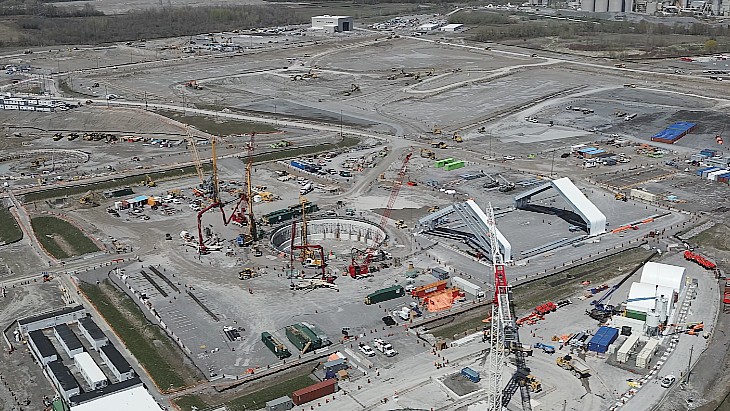Workshop examines nuclear opportunities beyond electricity

The second session of the High-Level Workshop on the Outlook for Nuclear Power in Clean Energy Transitions looked in detail at the additional contributions from nuclear power particularly through advanced technologies and applications.
Broad portfolio
Focusing on power generation alone will get the world less than halfway to its decarbonisation goals, said Uwe Remme, a senior energy analyst at the IEA. A broad portfolio of energy and energy technologies will be needed to reach net zero, he said, and identified four technology pathways for decarbonisation: electrification, hydrogen, bioenergy and carbon capture, utilisation and storage (CCUS). Hydrogen will be a "key pillar" for reaching energy and climate goals: hydrogen and hydrogen-based fuels will provide about 6% of the cumulative emissions reductions needed to reach net zero by 2070, he said.
There are several promising technology options to use nuclear energy in hydrogen production but nuclear's role remains uncertain and will depend on economics compared with other low-carbon options, Remme said.
Scenarios from the Intergovernmental Panel on Climate Change compatible with its 1.5 degree Celsius climate change objective call for a growing role for nuclear power, noted Michel Berthélemy, nuclear energy analyst at the OECD Nuclear Energy Agency. Speaking on behalf of Diane Cameron, the head of the NEA's Division of Nuclear Technology Development and Economics, Berthélemy said long-term operation (LTO) of existing nuclear plants is "by far" the most competitive source of electricity today, but the choice to pursue LTO is driven by policy decisions.
Nuclear new-build projects using existing Generation III technology are currently perceived as costly, but construction will need to be ramped up to meet 2050 decarbonisation objectives. With several first-of-a-kind (FOAK) nuclear projects nearing completion in several OECD and non-OECD countries, he said, data suggests a trend of cost reduction as design maturity is attained and lessons are learned from FOAK projects.
Small modular reactors (SMRs) will broaden market opportunities for nuclear, he said. Small and large reactors must been seen as complementary, and nuclear's contribution to power system flexibility - helping to integrate large shares of variable renewables - will be important.
Non-electricity applications of nuclear, including district heating, desalination and process heat for industrial applications - such as the production of hydrogen, chemicals and synthetic fuels - will play a critical role in "hard-to-abate" sectors, Berthélemy said. A range of historical and recent experience of nuclear heat applications around the world shows that the maturity of such applications is already there. "The issue is not so much the technology … it is moving towards demonstration and getting the right support," he said.
Strategies beyond electricity
Nuclear power is a mature industry in Russia, providing 20% of the country's electricity today, said Vladimir Artisyuk, who is an adviser to the director general of Rosatom. In the near term, nuclear offers a solution for low-carbon hydrogen production via electrolysis, and in the longer term, from high-temperature gas-cooled reactors (HTGRs). Rosatom aims to produce 50 million tonnes of hydrogen - 10% of global production - by 2050.
China today ranks third in the world in terms of installed nuclear capacity, but nuclear technology in the country is still in a "catch-up" phase, Professor Sheng Zhou of Tsinghua University said. Nuclear is economically attractive in China, with a substantially lower tariff than wind and solar, he said. China's target of achieving carbon neutrality by 2070 - announced last year - will create opportunities for both renewables and nuclear.
Beyond electricity production, Zhou drew attention to the promise shown by nuclear heat in two sectors that China is investigating: hydrogen-steel making and district heating. Current steelmaking methods result in annual carbon emissions of more than 1.5 gigatonnes per year, from energy use and coke production. Hydrogen-steel making - where hydrogen replaces coke - could potentially reduce those emissions. R&D is under way now, Zhou said, and a commercial demonstration unit using a 600 MW HTGR for both hydrogen and electricity production is envisaged by 2030.
Replacing fossil fuel consumption for district heating with nuclear heat can also lead to significant reductions in carbon emissions. China's first commercial nuclear-powered district heating project officially began operations in 2020, using heat from the Shandong Haiyan nuclear power plant to provide heat across an area of 5.2 million square metres, reducing CO2 emissions by 300,000 tonnes, he said.
UK models the future
The UK government late last year set out a long-term strategic energy vision consistent with reaching net zero in 2050. All but two of its existing nuclear plants - Sizewell B and the under-construction Hinkley Point C - are due to retire by 2030, Stuart Younger of the Department for Business, Energy and Industrial Strategy, said. He described how BEIS had used its Dynamic Dispatch Model to analyse the electricity system in 2050, modelling possible combinations of technologies for "plausible" low-carbon generation pathways, including gas with CCUS, wind, solar and nuclear, and testing deployment mixes with and without hydrogen replacing unabated gas. In total, around 700,000 individual scenarios have been tested, he said.
The BEIS analysis has shown there is no single optimal technology mix, as many capacity mixes can meet different emissions levels at low cost, he said. Without using hydrogen, low-cost solutions to reach below 5g CO2 per kWh by 2050 will need a combination of primarily renewable generation, but also nuclear and gas with CCUS, he said. System costs at low emission intensities are lower if hydrogen is used, and while it is possible to achieve this without nuclear, "in most scenarios, this still needs a combination of nuclear, [gas] CCUS and renewables, as well as hydrogen", he said.
Heat accounts for 37% of total UK emissions and is therefore a key area to cut emissions on the path to net zero, Aiden Peakman of the UK Nuclear Innovation and Research Office said. Some 75% of the UK's current industrial energy demand is for heat, and most of this is for heat below 500°C. Light water reactors can meet demand for heat around 300°C, while many Generation IV reactors could offer heat in the 500-1000°C range, which would also offer improved hydrogen production efficiency, he said.

_99697.jpg)








_79311.jpg)

